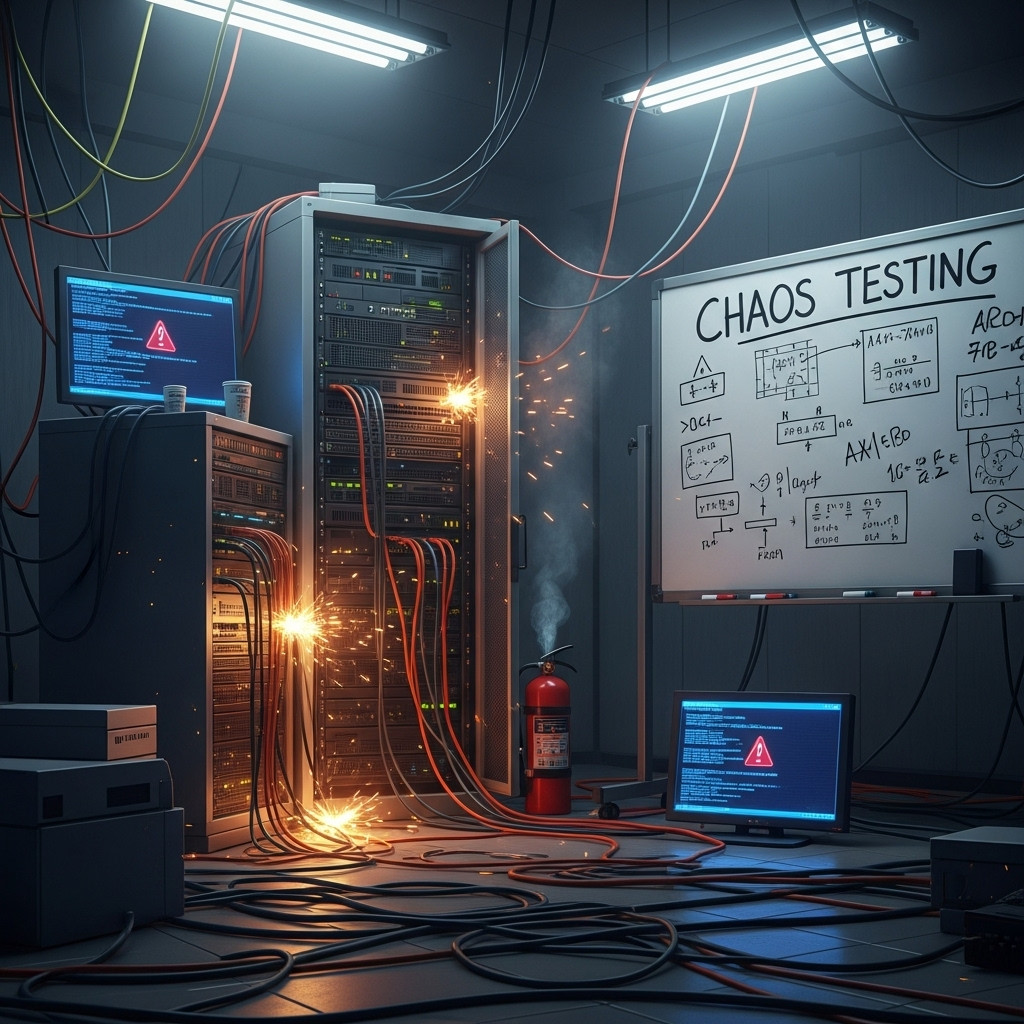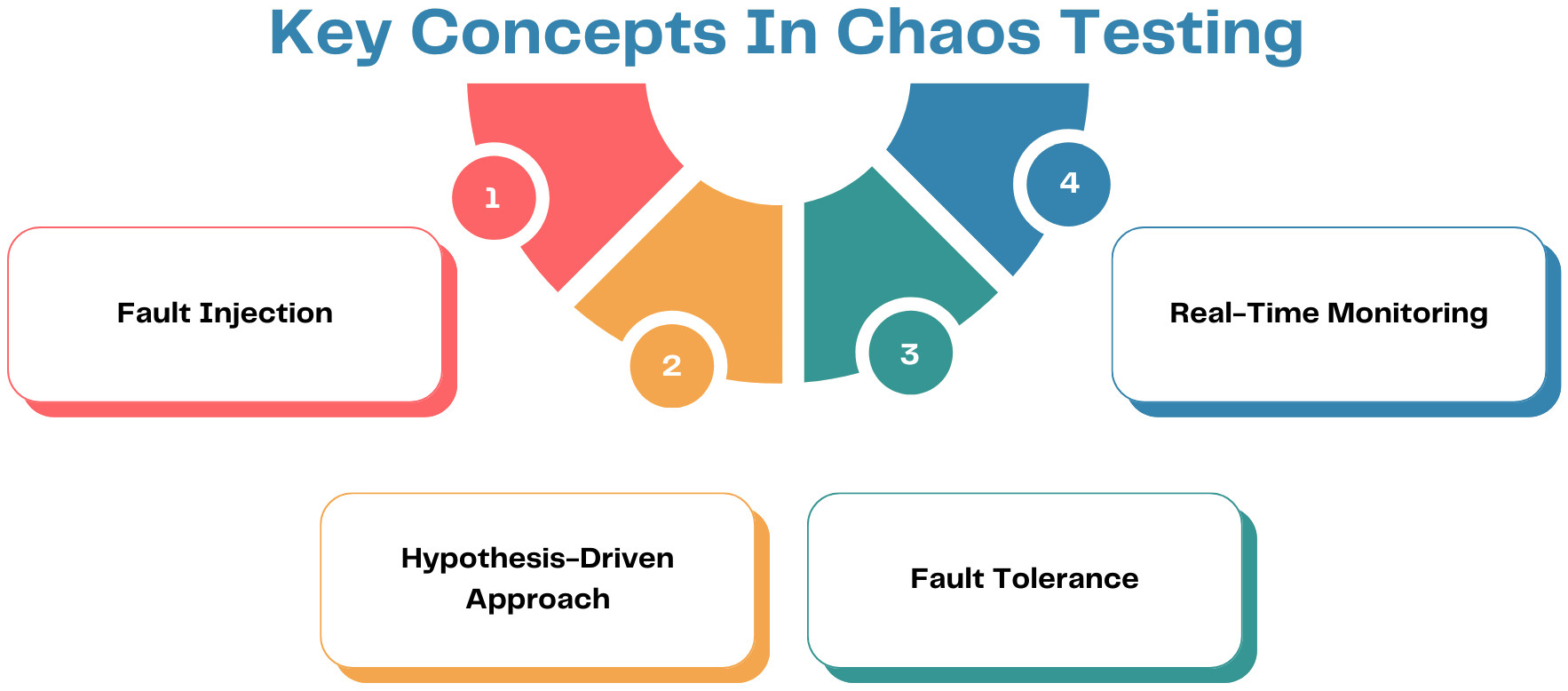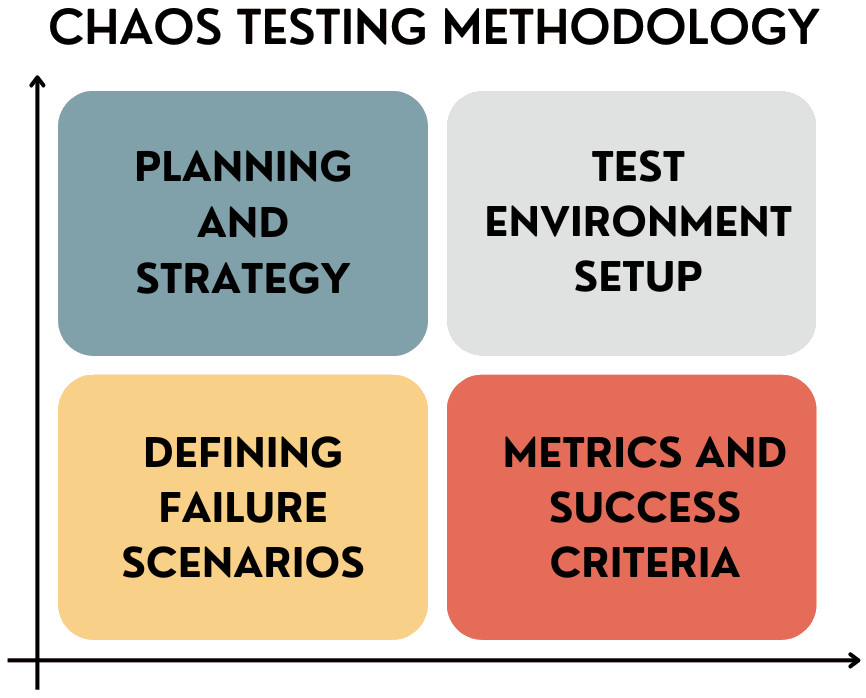What is Chaos Testing?
|
|
When it comes to modern systems that are digitally connected on all possible ends; unanticipated failures can be very expensive as it may not only cause downtime but also annoy the user. Knowing how gracefully your application can deal when it suddenly breaks is important. This is exactly where chaos testing proves its value, enabling teams to uncover weaknesses and reinforce system resilience before real incidents occur.
| Key Takeaways: |
|---|
|

What is Chaos Testing?
Chaos testing is a way of making systems dependable and strong by deliberately causing errors or failures within them. This active way will enable teams to see how the system is handled when there are uncertain disturbances, server failures, latency, or burning of a resource. Through hands-on failure simulations in real-world applications, chaos testing allows one to discover vulnerabilities, increase system resilience and make sure that critical services can endure under stressful conditions to end up with more resilient and fault-tolerant systems.
Usefulness of Chaos Testing
Chaos testing has gained prominence in recent software development, especially in large-scale distributed systems. Due to both the complexity and scale of systems increasing over time, the use of traditional testing may not help find all possible sources of failure in a system in dynamic environments, which require testing in real-time. One way of eliminating that gap is by chaos testing: exposing the system to systematic faults in order to get a closer look at how it would behave under pressure and expose any vulnerability.
The increasingly popular use of microservices, cloud systems, and continuous delivery also creates a greater necessity for chaos testing. Microservices that deal with numerous autonomous components with inter-communication via the network allow more failures to take place as a result of the dependence of the system and communication problems.
Chaos testing guarantees that these systems are resilient to disruptions and can continue to operate in realistic failure scenarios and as such, is an important procedure to perform to guarantee resilience of such systems in the current complex infrastructure.
Chaos Engineering and Traditional Testing
Unit tests and integration tests are the concrete testing methods to check that a system is behaving in a manner that we expect to be in the known and controlled circumstances. These are the tests of certain inputs and outputs, as the accuracy of functioning of certain matters or the whole system is the measure of their specifications. Unit tests are normally used to test functions or modules individually, whereas integration tests are aimed at layers to test how they work properly. The aim will be to make sure that the system behaves in a predictable manner, as expected of it, under normal operating conditions. Conversely, chaos testing deliberately destroys the system by the insertion of unknown faults and problems.
| Aspect | Traditional Testing | Chaos Testing |
|---|---|---|
| Goal | Ensure the system works as expected under normal, predictable conditions. | Understand how the system responds to unexpected, random disruptions and ensure it can recover gracefully from failures. |
| Approach | Focuses on checking for expected behavior. It tests whether the system works correctly when all inputs are within known parameters. | Deliberately introduces faults or failures into the system to test how it reacts under stress or failure conditions. It simulates real-world problems that might otherwise be missed in traditional tests. |
| Scope | Limits testing to predictable scenarios and known failure points. | Simulates random and unknown faults, testing the system’s ability to handle unforeseen issues and maintain operational stability. |
Principles of Chaos Engineering
Chaos engineering is formulated on top of a list of operational principles aimed at enhancing system reliability and resilience. These principles are contained in the testing systems in a manner that has not been done in the customary testing techniques, and which can enable organizations to detect weak areas in directions that would not likely occur in the real-life production environment.
Build a Hypothesis Around Steady State
The main aim of chaos engineering is to gain the comfort that a system will be able to deal with unexpected disturbances, like a server going down, network delay, or lack of resources. In traditional testing, it may be expected that one is testing a system that is going to be used in highly predictable and controlled conditions. Nevertheless, the system in the real world suffers random failures that might lead to degradation of the system performance, outage, or even loss of data.
Chaos engineering is a solution to this problem, and it is caused by deliberately adding faults into the system to monitor system stress behaviours.
Importance of Experimentation
The chaos engineering practice is based on the experimentation idea. Just like scientific experiments, chaos engineering implements an experimentation process to determine how the system reacts in the face of failure. At the centre of this kind of approach, there is the idea that systems must be able to tolerate failures and that these failures must be injected deliberately and systematically in order to learn useful things.
- Hypothesis-Driven: Engineers are initiated with that hypothesis of how the system is expected to act when a failure is incorporated. For example, on a crash of a server, recovery should occur in 2 minutes and this should not impede end-user experience.
- Experimentation: The second measure is to use specific affected faults, like shutting down a server, simulating network latency and see how the system reacts.
- Data-Driven Learning: Data obtained as a result of the experiment either proves or disapproves the hypothesis. When the system behaves well when stressed, one feels more confident in the resilience of the system. When it does not come back as it should, engineers will know where they need to make improvements.
Context of Chaos Engineering
During the early 2010s, when Netflix was in the process of migrating to the cloud, it encountered a problem of how to ensure its services to users could be kept highly available and reliable, given the unpredictable nature of cloud infrastructure. The classical way of testing was not enough to reproduce realistic failure cases, which might occur in a dynamic cloud environment. In response to this, Netflix’s engineering team created the first tool in a series of tools, Chaos Monkey, in 2011, to test the robustness of the system.
After Chaos Monkey had succeeded, Netflix extended the strategy to a series of tools, the so-called Simian Army, which is a set of tests trying to check various properties of the system’s resilience. These were tools that included:
- Chaos Gorilla: Imitated the collapse of the whole Availability Zones in the cloud to find out the capability of the system to survive a large-scale failure.
- Latency Monkey: A tool that introduced latency to the network between services to verify how the system would cope with weaker-than-anticipated replies.
- Conformity Monkey: Made sure that instances were being built in best practices of configuration so that the misconfiguration that might cause failures were being avoided.
Chaos engineering has spread past Netflix, with other tech-giants such as Google, Amazon, and LinkedIn, taking on chaos engineering practices, and creating their own tools to ensure their systems are reliable. The tools such as Gremlin, Chaos Mesh, and LitmusChaos are built to assist organizations in implementing chaos engineering on modern and containerized environments as well as microservices.
Key Concepts In Chaos Testing
Let’s look into the major concepts of chaos testing.

- Fault Injection: Involves the intentional insertion of faults or failures into a system as a way of testing how such a matter can be handled in real-world situations. Adversary injection is intended to determine vulnerabilities in the system and how the system can maintain stability in case of unforeseen system failure.
- Hypothesis-Driven Approach: Chaos testing comes out of a scientific method approach, where every test starts with a hypothesis. The hypothesis relies on the behaviour that the system is anticipated to take when some faults or disturbances are introduced. An example of a hypothesis would be, “When a server is down, the system ought to be back up in a maximum of 2 minutes without the service being affected to the user.”
- Fault Tolerance: Fault tolerance is the capability of a system to remain functional without an interruption, long after some parts fail to work well. A fault-tolerant system is constructed to accommodate a failure with little or no performance or user experience disruption. Fault tolerance is one of the main characteristics to which chaos testing is subjected.
- Real-Time Monitoring: In chaos testing, real-time monitoring is vital because it allows the team to determine which performance degradation occurs and which weaknesses within the system are discovered in the course of the experiment. In chaos testing, the system is purposefully abused by introducing faults into it and in real-time, the reaction of the system is monitored via monitoring tools.
How Chaos Testing Works?

The process of chaos testing follows a structured scientific method:
- Planning and Strategy: Planning is the initial phase of chaos testing, and it is during this stage that teams involved find crucial systems and outline the extent of testing to be conducted. The phase is important since it can enable the selection of the systems and components to be tested so that the most critical services and areas are the first to be tested. Read more about test planning: Test Planning – a Complete Guide.
- Test Environment Setup: After the planning is done, the next thing is to come up with a test-controlled environment where the introduction of faults can be done safely as far as production systems are not compromised. The right testing environment guarantees that experiments take place outside the production systems and are not able to accidentally cripple services. Understand about test environment: What is a Test Environment?: A Quick-Start Guide.
- Defining Failure Scenarios: To formulate failure situations is a critical role of chaos testing, because they define what kind of faults are applied to the system. The state of such scenarios is to closely resemble real life disruptions which can occur at any stage in the lifecycle of the system.
- Metrics and Success Criteria: There are measures and conditions of success worth defining in order to determine the success of chaos testing. These metrics assist in evaluating the system with regard to the degree to which this system is capable of managing disruptions and attains to reliability. These measures include system uptime, response times, error rates, recovery time, and user experience. Understand more about QA testing KPIs: QA Testing KPIs: Driving Success Through Measurable Metrics.
Advantages of Chaos Testing
- Enhanced System Resilience: Chaos tests enable organizations to maintain system reliability by injecting various forms of failures, such as server crashes, network latency, or resource exhaustion, which normal test suites may not cover. Hence, they uncover those blind spots and make the team improve the most fragile areas so that the system can deliver performance and availability under adversarial conditions.
- Faster Incident Recovery: Chaos testing simulates failures to help teams detect faults, resolve bottlenecks, and enhance recovery mechanisms long before a real incident happens. This shortens the downtime and reduces user impact during real outages.
- More Confidence in Production Systems: This is what gives teams the confidence that systems respond predictably to real world disruptions. It concerns the early detection of vulnerabilities that provides the ability to harden defenses and as a result, systems can take attacks with minimal harm.
- Acceptance Culture of Failure: This is where chaos testing helps to transform the culture within which failure is seen as a learning experience and not something to mitigate. It also builds a culture of innovation and incremental improvement, as well systems that are designed to handle events and recover from them.
Challenges and Considerations
- System Complexity: It is difficult to apply chaos testing on complex systems or microservices in which every interconnected component has its own behaviors, dependencies, and failure modes. One service disruption can lead to unforeseen downstream effects throughout the system.
- Risk Management and Safety: For anything customer-facing, it increases risk of running chaos tests in production as the same can result in outages, reduced availability or data loss, consequently affecting the business and its users. Read: Testing in Production: What’s the Best Approach?
- Cost of Implementation: IChaos testing is a difficult and mundane task, which is dependent on various factors such as the complexity of infrastructure, the need for tools required, and also a range you want to do testing.
- Influence on Development Cycle: Failure injection for chaos tests, including inserting failures during chaos tests, is typically time-consuming because once the failure is injected, monitoring and analysis of these issues must be done to resolve them, which typically takes a long time.
Tools For Chaos Testing
Let’s look into the most popular tools available in the market for chaos testing.
Chaos Monkey
Among the most recognizable tools of the chaos engineering world is Chaos Monkey created by Netflix as an element of Simian Army. Chaos monkey is intended to kill services randomly in the cloud (e.g., Amazon Web Services) just to resemble the unknown failure that might take place in production. Chaos Monkey allows us to account for how the system could gracefully handle instance failures, redirecting the traffic to those that were not damaged and ensuring that the system is not too dependent on particular instances. This helps build fault-tolerant and resilient infrastructures.
Gremlin
Gremlin is a complete chaos engineering platform that offers a set of interfaces to introduce a range of failures into an application. In contrast to tools which can only inject failures in a narrow scenario, Gremlin has a large number of fault injection capabilities, including network latency, CPU stress, memory stress, etc. Gremlin enables the chaos testing to be carried out by the engineers in a controlled manner, and there is no danger of lengthy downtimes of significant parts of the system caused by introducing a failure scenario.
Chaos Mesh
Chaos Mesh is an open-source platform that specifically implements Kubernetes environments in chaos engineering. As the number of firms move towards containerized apps that need orchestration by Kubernetes, Chaos Mesh has proven to offer a crucial set of tools to introduce chaos to Kubernetes clusters.
Automated Chaos Testing
testRigor provides powerful capabilities for implementing automated chaos testing. Its cloud-based environment allows teams to execute tests seamlessly across multiple browsers and devices without the burden of complex infrastructure preparation. The intuitive no-code interface enables participation from all team members, and its comprehensive reports make it easier to pinpoint and resolve vulnerabilities discovered during the process.
Conclusion
Chaos testing is already proven important, but as systems become increasingly complex, especially with the emergence of such concepts as microservices, cloud-native applications, and serverless architecture, chaos testing will continue to gain importance. Integration of next-generation automation tools like testRigor helps chaos testing in automatic identification of failure scenarios, predictions of system weaknesses, and analysis of system behaviour during the chaos experiment.
Chaos engineering will only improve as organizations demand greater uptime and consistent high-availability expectations are implemented.
| Achieve More Than 90% Test Automation | |
| Step by Step Walkthroughs and Help | |
| 14 Day Free Trial, Cancel Anytime |












